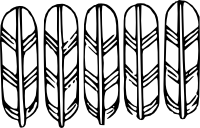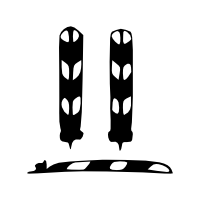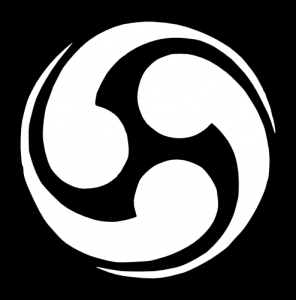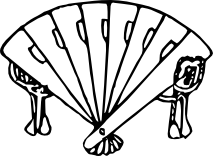Recreational research into Feudal Japan
Posts tagged Heian period
On Kissing
Nov 22nd (a Tomobiki (友引))
Once, many years ago, I read the following in Shinjū, by Laura Joh Rowland, a mystery novel set in Edo Japan.
But he’d never tried seppun, the exotic practice of touching mouths that had been introduced to Japan by the banished foreign barbarians. (p. 123)
Being naturally a trusting sort, I took this at face value and assumed the Japanese hadn’t kissed before the Portuguese arrived in 1542. But more recently, I read an interesting passage in the Tosa Journal, written around 935 by a courtier.(CJP:77)
People simply kissed the lips of pressed salted trout. (I.e., nibbled at their heads.) Do you suppose the trout found it romantic?
Is this evidence of pre-Western-influence romantic kissing? Certainly looks like it. But absent other evidence, I had to wonder what exactly was in the original and if anything had been added in translation. Looking at the original, several things are clear. The expression here is “kuchi wo sufu”1, literally “suck lips”, which does seem to specifically be an idiom for kissing. The romantic bit turns out to be “omofu yau ara n ya”, something along the lines of “perhaps they helplessly have longing”, omofu having among its various possible interpretations ‘think of’, ‘recall fondly’, ‘long for’, ‘love’, and ‘cherish’. I think we can fairly say, then, that my doubts of Dr. McCullough’s translation were unmerited. As for Westerners having introduced romantic kissing to the Japanese, as we say in the biz, “Myth Busted!”
I have also posted a complete translation of these two sentences.
Many thanks to Mister Bean (ミスター ビーン), whose analysis and translation of this passage into modern Japanese was quite helpful.
Element of the Week: Feathers
Sep 27th (a Sembu (先負))
Today we look at a straightforward motif in mon: feathers. Generally described as hawk’s feathers (or, depending on translation, falcon’s feathers), they are graphically simple and have flexibility in number and arrangement. They have a military connotation, both from hawks being hunting birds and from the tradition of fletching arrows with feathers from birds of prey.(Kyudo) Falconry was also a popular and respected sport for both samurai and nobility from the Heian Period (794–1185).(Dower:94)
Here we have a simple 5-feather mon from the Muromachi-period collection of provincial samurai mon.(KJ:7) It shows the more free-form nature of earlier mon by being notably wider than it is tall, which became rarer as mon became more formalized.
 Watch movie online The Lego Batman Movie (2017)
Watch movie online The Lego Batman Movie (2017)
This even earlier mon, used by the Kikuchi family in the 14th century,(SH:14) is interesting for its use of a half feather, an unusual way of creating a distinctive mon. The same family would later use other mon incorporating an even two feathers.(en.wp:Kikuchi_clan)
Motif of the Week: Folding Fans
Jun 14th (a Senshō (先勝))
A while back we talked about one type of fan used in mon, but the type of fan everyone associates with Japan is the standard folding fan. This was a very popular motif in mon through the centuries. Its origins as a design motif date to the Heian period (794–1185).(Dower:110)
Here are two folding fans from our collection of 15th century provincial samurai mon.(KJ:7) The one on the left is a cypress fan, which was part of the traditional court costume, with the number of slats used indicating the status of the holder.(Dower:110) The one on the right is of feathers. It’s stylistically related to the hemp palm mon, and is associated with tengu, the mythical “bird goblins” who would trick mountain travelers with illusions, and from there mountain asceticism and certain temples and shrines.(Dower:111)
A simple folding fan design with the sun-circle motif was used by Satake Yoshinobu at the Battle of Imafuku in 1614, in the early Edo period.(SH:H9,62) This style of papered fan, optionally with design, became the standard version of the folding fan for mon. This particular version is interesting because it breaks the standard two-color rule for mon, which would soon become inviolate, by using three distinct colors: black, white, and red.
Around the same time, we have a three-fan design used by Matsudaira (Okochi) Nobutsua, who we mentioned last week, at the Shimbara Rebellion in 1638.(SH:63) Making circles of fans is similar to the way circles would be made of some plants in mon.
Modern fan mon are very similar to these early Edo designs, but with more realistic handles that hearken back to the earlier fans we have here.(IEJFC:52.2)
On the Origin of Mon
Apr 26th (a Sembu (先負))
So, where did mon come from? While they’re often thought of as being used for battlefield identification, they didn’t start out that way. The first evidence of what became mon dates back to the Heian period (794–1185), when distinctive designs, some of which derive from Nara period (710–794) fabric patterns, were used by the Japanese imperial family and associated court nobility to indicate things like clan membership and religious affiliation.(ja.wp:家紋) One common design from this period is the simple “Shadowed, Nine Stars” design, shown below, used on an imperial ox-cart.(SH:4) “Shadowing” is the Japanese heraldic term for outlining. Note also the standard arrangement of large numbers of circular things, with one larger one in the middle, and the use of relatively large numbers in period mon.
Mon were initially associated with the court nobility and the Imperial family, and were used as decorations on clothing, carriages, and furniture rather than on banners and other stand-alone identification.(ja.wp:家紋) Still, they were a means of identification, and various court nobility families selected distinctive mon. In addition to geometric designs like this one, flowers, birds, and leaf patterns were common.(TM:45) Meanwhile, while warriors used distinctive banners for battlefield identification, these were of a simpler design. The first evidence of mon used for battlefield identification is in the Gempei War at the close of the Heian Period.(SH:10) We’ll look at some of these mon next time.Watch movie online Get Out (2017)
Pivot Points
Feb 15th (a Tomobiki (友引))
Japanese poetry traditionally putting strict limits on the number of syllables used, various figures of speech were employed to stretch those syllables as far as possible. One of my favorite is the kakekotoba, or “pivot word”.1 It’s a kind of pun based on using a single word twice for two different meanings. The way to think about it is this: come up with a sentence where a word would be followed immediately by a homophone. One of the two words can actually be longer, as long as the part that’s adjacent to the other word sounds the same. Then, when writing the sentence, only write the shared sounds once. Instead of a sentence having multiple possible interpretations, a word has multiple interpretations within a single sentence.(CJAG:366)
This doesn’t work all that well in English, but let’s give it a try anyways. Let’s say I’m writing a tanka about vampires. I might want to say “The kindred dread dawn’s swift coming.” Making ‘dread’ a kakekotoba, I can just say “The kindread dawn’s swift coming.”, saving one crucial syllable, and more importantly impressing my peers with my poetic cleverness. A slightly better example is “The sisters pine incense fills the air.”2
Kakekotoba work better in Japanese than in English for several reasons. Firstly, Japanese has a lot of homophones. Having a more limited set of syllables to build words from increases your chance of collision a lot; part of the reason the Japanese writing system is so complicated is to tell homophones apart. Secondly, phonetic spelling: if two words sound the same, they’re (most of the time) written the same way in hiragana,3 so you don’t have spelling conflicts like I did with ‘kindread’. Finally, Japanese grammar rules are a little more flexible about word placement, so it’s easier to get the proper juxtaposition.
Here’s a Japanese example from the Kokinwakashū (dating to 914, in the Heian Period). It uses one of the classic examples: the word “matsu” can either be the verb “to wait” or a pine tree. Here, the tree interpretation is actually the first part of the name for a specific kind of insect.
Following Directions
Feb 8th (a Shakkō (赤口))
A few weeks ago, I talked about Rokuyō, the six-day calendar cycle of varying auspiciousness. Another key part of Japanese astrology, or Onmyōdō1, was concerned with auspicious and inauspicious directons.(en.wp:Onmyōdō) Which directions were auspicious or inauspicious for a given person, along with monoimi (personally inauspicious days), were determined by Onmyōji, professional diviners licensed by the court. They depended both on the calendar and on the time of day, in a similar way to the Rokuyō.
These divinations weren’t limited to cardinal directions; 24 directions were used, associated with animals in the Chinese zodiac, the 10 calendar signs (each in turn a combination of one of the 5 elements2 and yin or yang), and one of the eight trigrams of the I Ching.(ja.wp:干支) These associations were often mapped out with ornate compasses along the lines of the following.
Read the rest of this entry »











